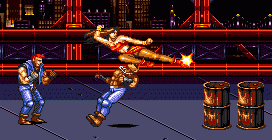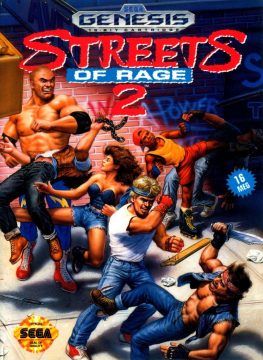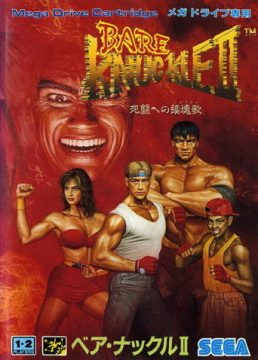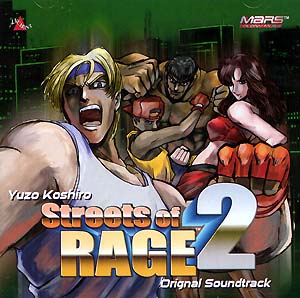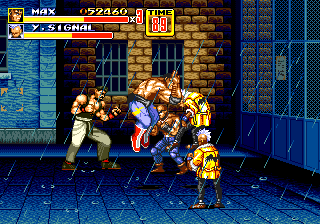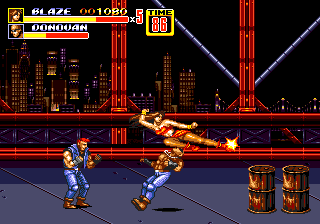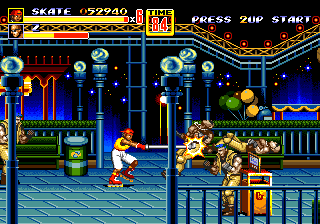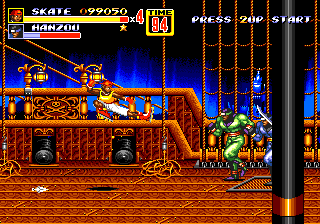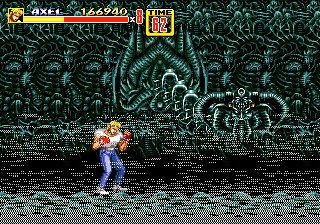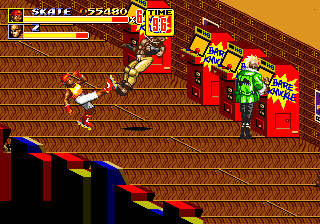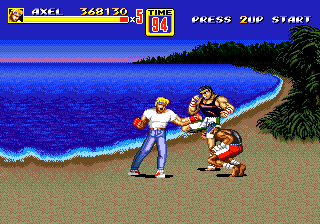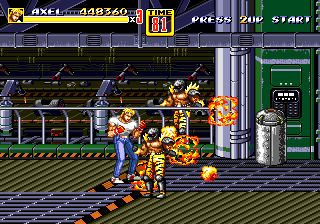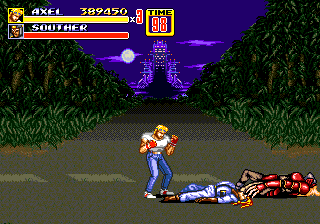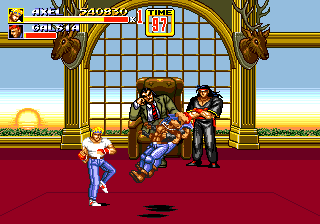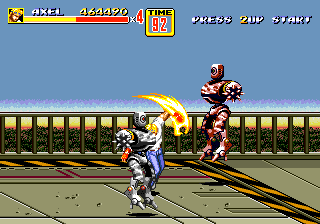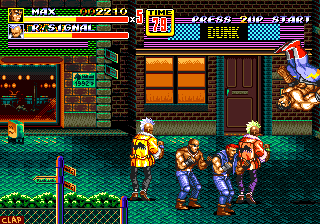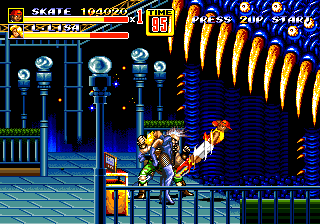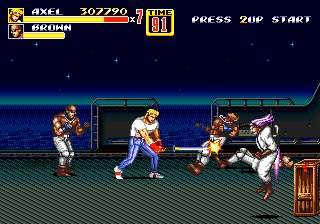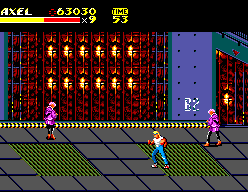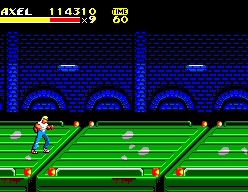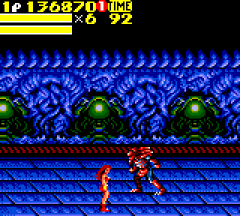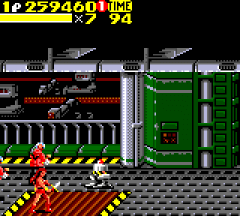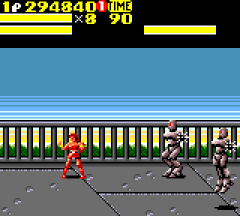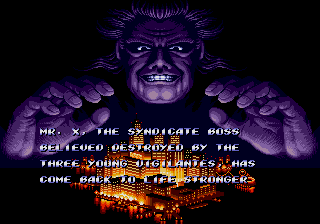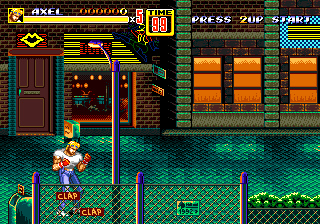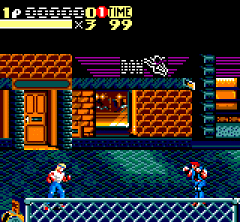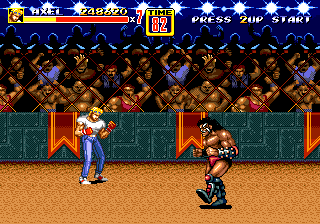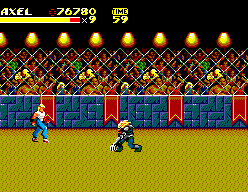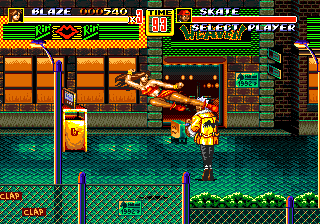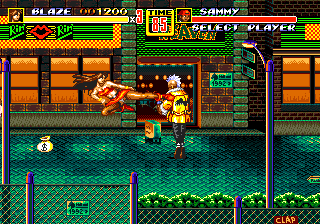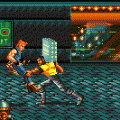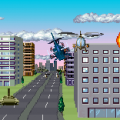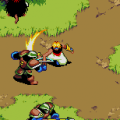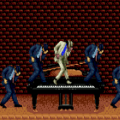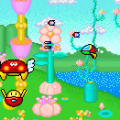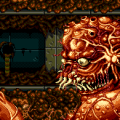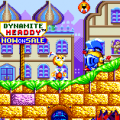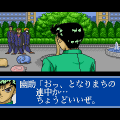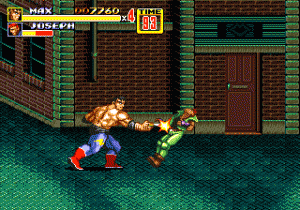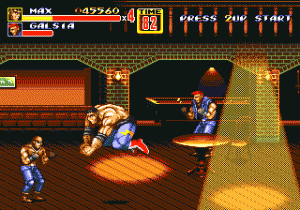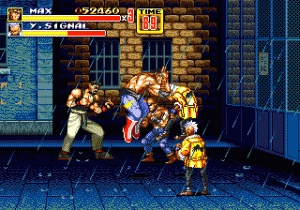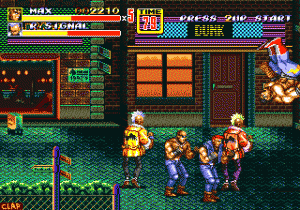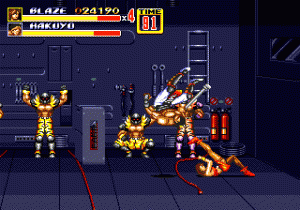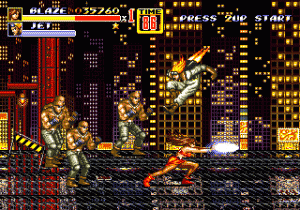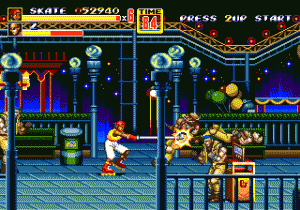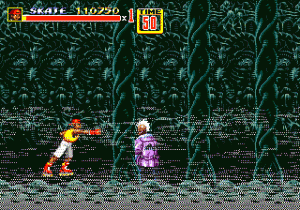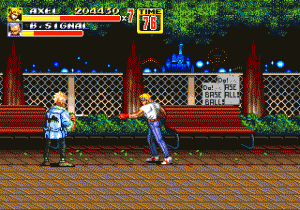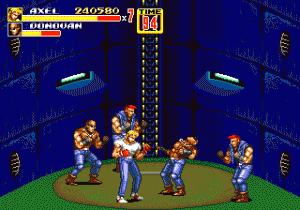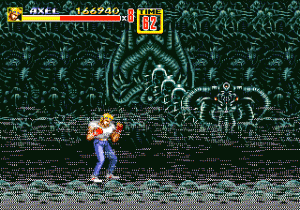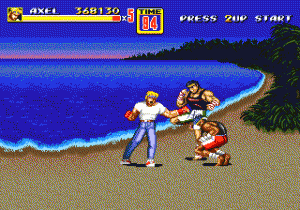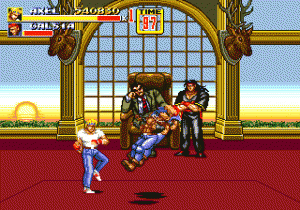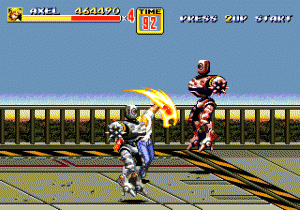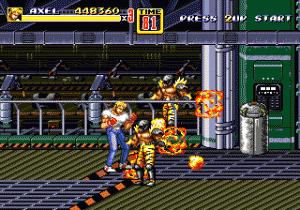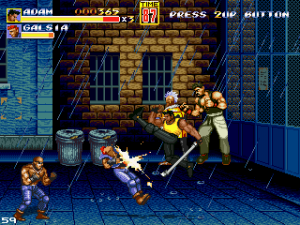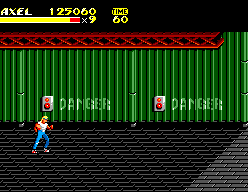After a middling first effort, Sega would make some massive improvements with their sequel, making a game that could easily stand up to, and in some ways, even surpass Capcom’s brawler. Especially when you put it up against Final Fight 2, which was more of a rehash of the original game, with the missing features of the original game included. This is the game almost everybody thinks of when they think of the Streets of Rage series, and there are many good reasons for that. Not to mention that it’s quite possibly one of the finest beat-em-ups you’ll find on Sega’s console.
One year after the events of the first game, Mr. X has, as the introductory cutscene phrases it, “come back to life”. It could be that they meant this metaphorically, like a new guy took his place, or maybe they actually mean that he ended up just magically being resurrected, like Castlevania’s Dracula. Who knows. In either case, Mr. X sends out a new wave of minions onto the city. He’s also captured Adam in an attempt to lead Axel and Blaze into a trap. This time, however, is that they’re joined by Max Thunder, Axel’s pro wrestler friend, and Skate, Adam’s kid brother. Yes, the good guys have no qualms about sending a young child out to fight The Syndicate with little more than his bare hands and a pair of roller skates. In all fairness, however, he can kick as much ass as the grown ups, and the idea of a preteen taking a katana to a small country’s worth of gangsters is a little hilarious.
“Each of the four playable characters is far more diverse this time around in both their stats and the moves they can perform, fixing one of the original game’s greatest flaws. Blaze is the most balanced of the four, with an equal mix of power and speed. Axel leans just a little more towards power than agility, but he’s well-rounded enough that he also makes a great starter. Skate doesn’t have quite the same damage output as the rest of the characters, but he’s incredibly fast, and is the only character capable of performing a dash. Max, on the other hand, is very slow, but he has a few moves that can just about remove an entire health bar if they connect.
Each character’s moveset has also been greatly expanded, giving you a lot more options. All the maneuvers you could perform in the first game, like vaults, back attacks, throws, and team attacks are mostly executed the same way. Max cannot vault like the other characters, but he can jump while holding onto an enemy, allowing for air throws and the deadly atomic drop. The cop car special does not return, but with all the new moves available for use, it’s hardly missed. Among the new special moves are a couple of new additions as well — a jumping jab attack that’s great for starting off a combo, and a charge attack performed by holding down the attack button that excels at knocking down foes quickly.
Each character gets an assortment of special moves instead. Pressing the new ‘special’ button while neutral performs a Final-Fight esque crowd clearing move at the cost of some health. Holding forward while pressing the special button does a different special that deals good damage to whatever foes are in front of you. Finally, by double tapping forward and pressing the attack button, each character has a ‘blitz’ move, like Axel’s firey ‘Grand Upper’ attack. These moves don’t cost health to perform, so they’re great for knocking down foes and adding a little extra damage to your basic attack string.
Enemies have received a major overhaul as well, providing much more of a challenge in the process. They’re generally far more agressive this time around, and their attack patterns are much more distinct. Galsias with knives, for example, slowly charge directly towards you, carrying a deceptive hitbox with them. Donovans love to knock you out of the sky, making it safer to approach them on the ground. Signals love to throw you, which makes them a lot less dangerous if you know how to recover from being tossed. Each enemy has their own distinctive patterns and quirks, which makes learning the game a lot more rewarding.
The entire game feels far faster and snappier overall, which makes everything feel immensly more satisfying. The game is fast enough that you can attack with a jumping jab attack to hold an enemy in place, launch into your basic combo, and then finish it off with your forward special move to unload incredible damage onto your foe. It’s not quite as advanced as such combo-heavy games as Alien VS Predator, but it makes for a game that feels even smoother to play than some of the best of its competition. Perhaps the only real flaw in the game’s combat are the handful of especially annoying bosses. Jet’s one great example — a guy in a jetpack who often ends up slipping out of your combo, where he can counterattack you easily.
The game’s eight stages offer far more in visual cariety this time around, something clear just from the first stage alone. You start off on a city street, before making your way down a darkened alley. From there, you enter a bar, complete with chairs and tables to smash, before fighting the bar’s lounge singer. The final segment then takes place in the back alley of the bar, with the rain picking up as you encounter the boss. The other levels are just as varied, featuring such enviroments as an amusement park with several attractions, a baseball stadium, and an island base leading to Mr. X’s new penthouse.
Once you’re done with the main game, there’s also a “Duel” mode, where two players can fight each other. Unfortunately, this mode does little to adapt the usual mechanics for one on one combat, which makes for what feels like an afterthought, at best. The several difficulty levels, however, do a great job at adding replay value. The Normal difficulty is surprisingly mild for the genre, with harder levels fixing this nicely.
The graphics have undergone a major improvement, with every character sprite now just as large, if not more so, than the boss characters of the original game. The extra level of polish is easy to see in the levels, as well, with an assortment of impressive graphical effects. The pirate ride on Stage 3 makes use of rudimentary background rotation, while the waters under the bridge on Stage 2 reflect the city skyline in the background. The music is even better now, and just about every track is instantly memorable. The sound effects are also a lot crisper, with plenty of meaty sounds as blows impact foes, and lots of digitized speech that adds just a little more impact to each move.
Streets of Rage 2 not only manages to outdo its prequel in every possible way, it’s more than competition for even quite a few arcade beat-em-ups it’s competiting with. It’s a classic of not only the system it saw released on, but of its entire genre. There’s few, if any flaws but the most minor to call out. One more sequel would see release before the series took a long hiatus, and its somewhat divisize nature speaks to the quality of this particular game well.
The Master System version also lacks co-op, along with any appearance of Max. Aside from that, the game does a good job of including all the moves. Unfortunately, the controls feel spotty enough that even basic things like recovering from a throw are never certain, and the hitboxes rarely feel like they’re in your favor. It doesn’t help that even on Normal difficulty, enemies are incredibly fast and aggressive — Jack especially has a bad tendency of putting you in a knockdown loop and clearing away an entire health bar. At the very least, the 8-bit renditions of the music are solid, even if they’re not nearly as memorable as their original versions, and there’s a handful of new areas, like a warehouse and the top of a subway train.
The Game Gear version is a marked improvement over the previous game, and is definitely the best 8-bit version in the series overall. Aside from Max still being missing, it feels remarkably close to the Genesis version, making for a remarkably smooth transition. The only especially odd things to call out are that specials no longer cost health. Truthfully, this doesn’t break the game that much, as it’s already somewhat on the easy side if you’re playing the default difficulty. Interestingly, this version gives every character a unique screen-clearing attack performed by holding the attack button for several seconds — Axel fires a massive fireball across the screen, while Skate somersaults back and forth across the screen. One wonders if this is where Guard Crush Games got the idea for SOR4’s ‘star moves’. In any case, it’s an incredibly solid port, so much so that it might be one of the highlights of the system.
The game was also released on both the MegaTech and MegaPlay arcade hardware. They’re mostly similar to the Genesis version, with a few differences, depending on which hardware you’re running on. The MegaTech version gives you a time limit that has to be extended by inserting more credits, while the MegaPlay version gives you credits for inserting money, like any other arcade game. It’s also a little more difficult in a few ways, like all the extra live pickups being replaced with score items.
Like the first game, Streets of Rage 2 appears on the Japanese version of Sonic Gems Collection, and was also released on the iOS with bad touchscreen controls. It’s also on the Sega Smash Pack Vol. 1 for the Dreamcast, which is an emulated version, with some truly terrible music that sounds like some of the FM channels were replaced with scratchy PSG.
The iOS version plays more or less exactly like the Genesis version, although, as with most smartphone gaming, the touchscreen makes things a lot less precise. The two player mode has also been removed entirely. Which is understandable, given what you’re playing it on, although having some kind of online play feature would have been nice, anyway.
There was originally a release on the XBLA, converted by Backbone, which was just an emulated version with online multiplayer. This has been replaced with a much better version of as part of the Sega Vintage Collection.
The 3DS version, like its predecessor, has some fantastic 3D effects. It also has the “Fists of Death” easy mode similar to the one found in the 3DS version of the first game, plus a “Rage Relay” mode, where you pick which characters you’ll switch to when one of them dies.
Screenshot Comparisons
